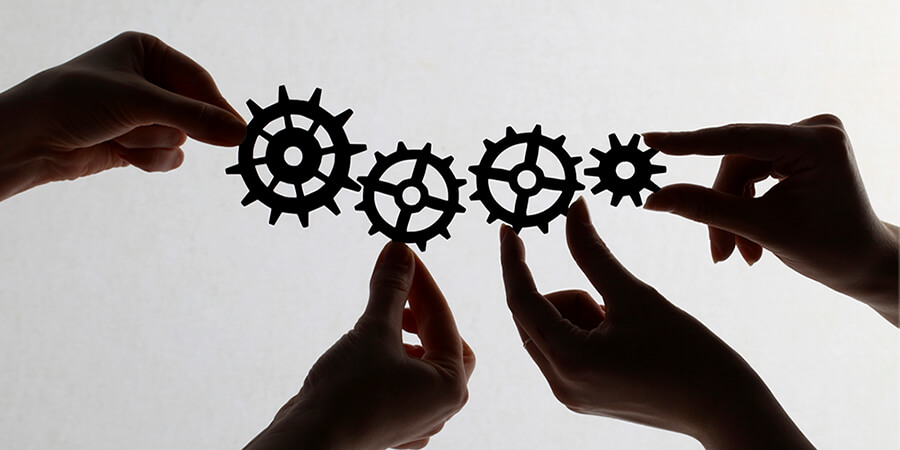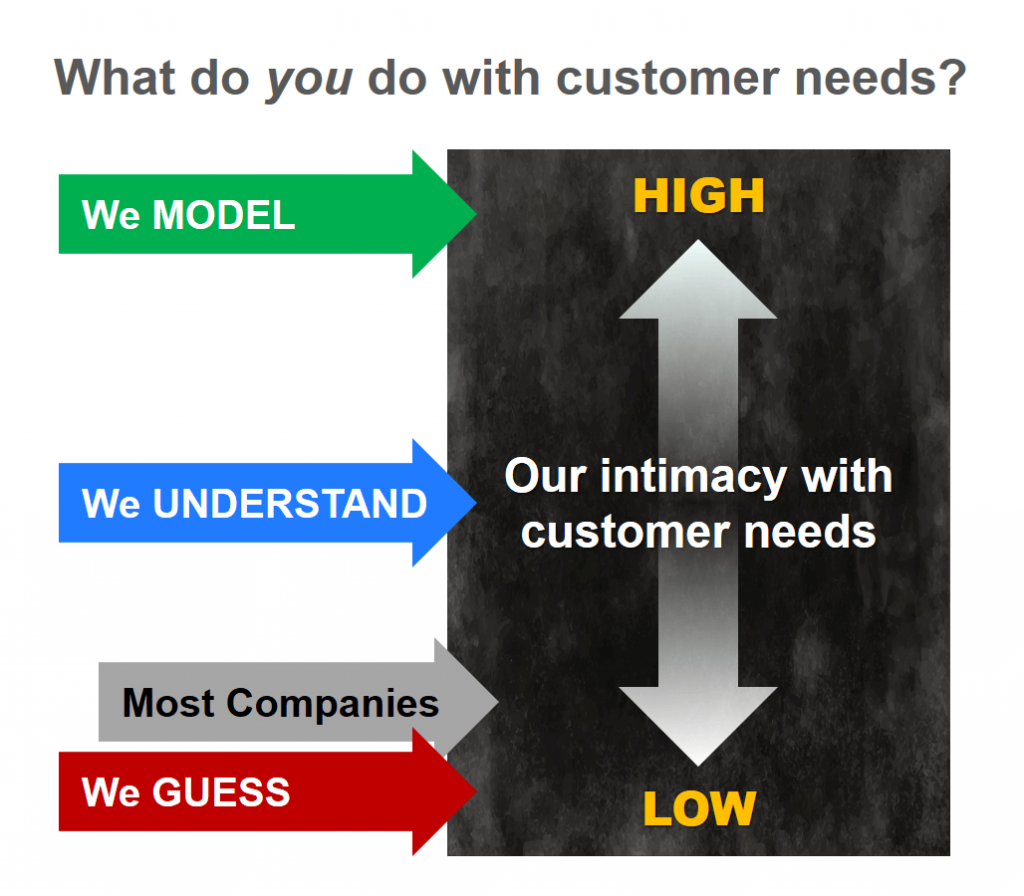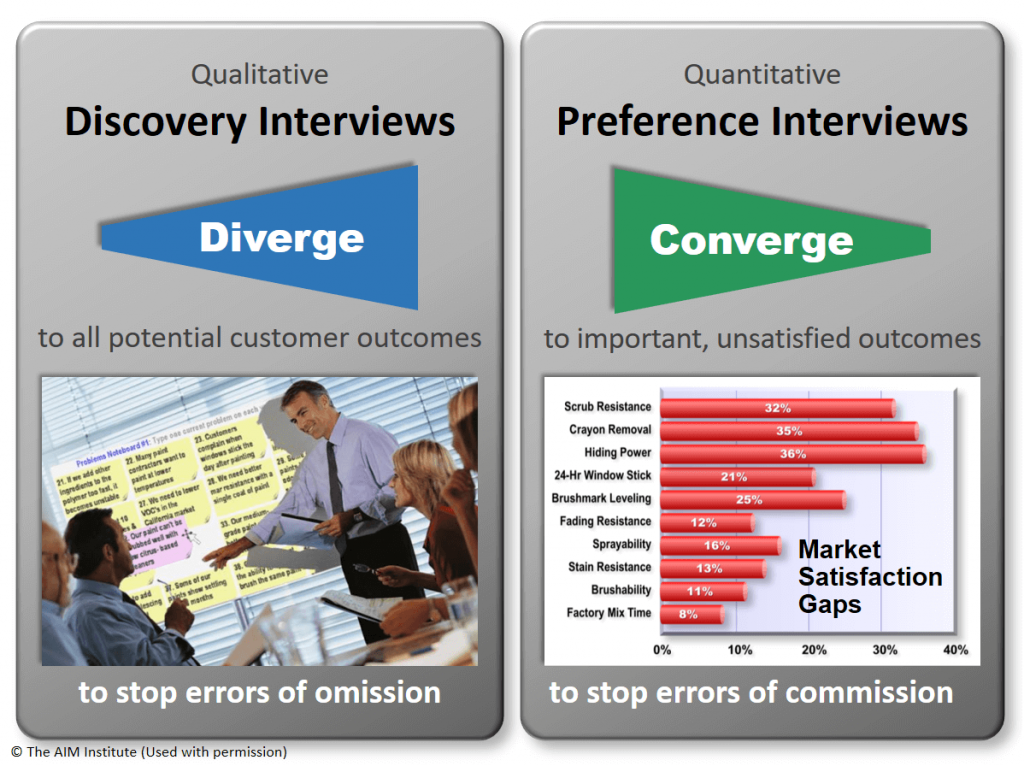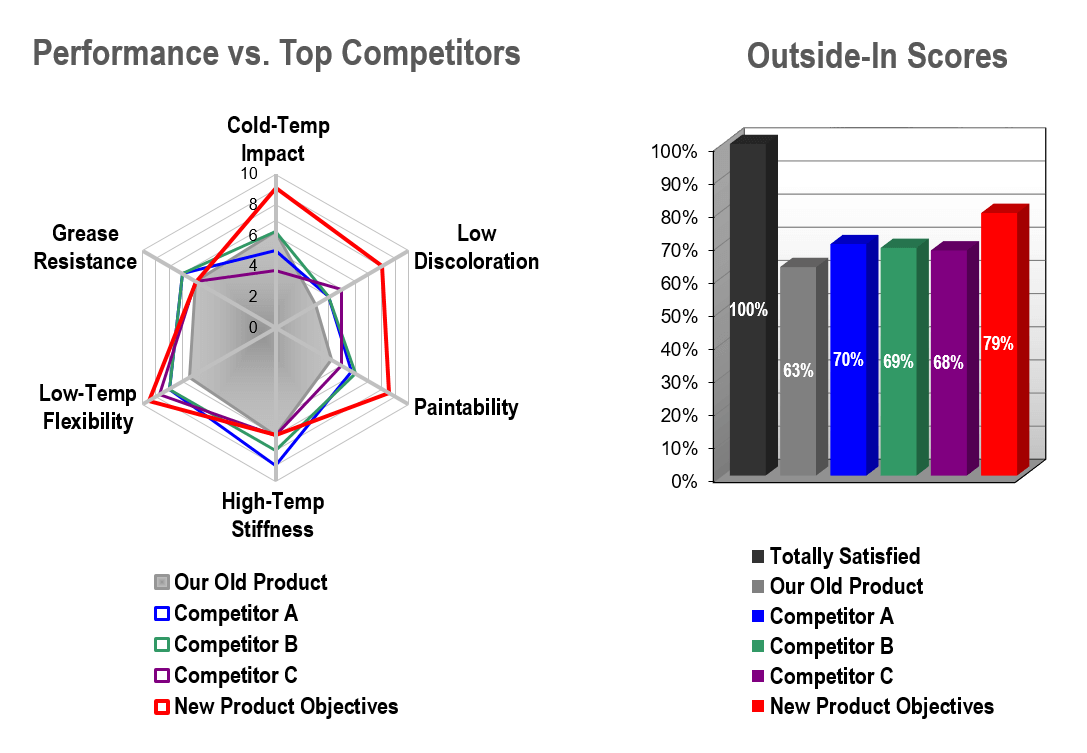B2B Customer Needs: Predict the customer’s experience with modeling

How well do we understand B2B customer needs? How well is this even possible?
Consider that a model is a simplified reflection of reality… a “stand-in” for what will happen. Maps, budgets, and recipes are models. Advanced scientific models help us predict hurricanes, solar eclipses and tectonic plate shifts. A good model…
- Incorporates all important predictive data and ignores the rest.
- Explains the past and predicts future real-world behavior.
- Provides cost-effective benefits in the real-world.
Your company’s relationship with customer needs lies somewhere on an “intimacy” continuum anchored by three points: We Guess, We Understand, and We Model. Before describing how to model customer needs—and why this is so important—let’s see what “guessing” and “understanding” look like.

Guessing and understanding customer needs
We recently researched the impact of B2B-optimized interviewing by 50 new-product teams from 20 prominent client companies. These teams had views of what their new products should look like before—and after—their 875 interviews. How much did these interviews impact their product designs? For only one out of every six teams was the impact “moderate” or “slight.” For five out of six teams, the impact was “great” or “significant.” (For more, see Guessing at Customer Needs at AIM Whitepapers.)
So it seems most B2B companies—without proper interviews—have a poor understanding of customer needs. They’re probably somewhere on the continuum between “guessing” and “understanding,” and probably much closer to the former. Your company is in this group if you…

- Start with your own ideas instead of customers’ ideas.
- Use customer interviews to “validate” your pre-conceived notions.
- Only learn how your new product will sell after you launch it.
When your company moves from “guessing” to “understanding,” you eliminate two types of errors: errors of omission and errors of commission. The first is failing to uncover unarticulated customer needs, and the second is selecting the wrong customer needs to pursue.
Click here to learn more about the B2B growth tools available from AIM
For years, Blueprinting practitioners have used divergent, qualitative Discovery interviews and convergent, quantitative Preference interviews to avoid errors of omission and commission, respectively. Many teams stop after these interviews… and that may be OK if your competitors are still guessing.
But some day even lagging competitors will stop guessing and start understanding. As the Quality Wave showed, Detroit automakers eventually had to close the gap with Japanese competitors. (See Catch the Innovation Wave.) Why not build modeling skills now to put maximum daylight between you and competitors for as long as possible?
Modeling B2B customer needs
When you model B2B customer needs, you learn enough to replicate the customer experience yourself. This only works for B2B. It is the complete opposite of B2C methods, where you ask customer to react to your prototype, hypothesis, sample, conjoint survey, price survey, minimum viable product, etc. Future innovators will understand this: For markets with a low B2B Index, use customer reaction. For a high B2B Index, use customer modeling. (Calculate your market’s B2B Index for free at B2B Market View.)
You don’t need to show customers your prototype and ask what they think… because you’ve modeled how they think.
With customer needs modeling you don’t seek customer reaction. You predict it. You don’t need to show customers your prototype and ask what they think… because you’ve modeled how they think. But you can only do this by first letting your smart B2B customers make you smarter during those “understanding” interviews mentioned earlier.
Just as a weather forecast model relies on key input data—barometric pressures, temperatures, and wind speeds—your interviews capture vital customer data in a measurable form. Imagine you make plastic, and customer interviews in your target market segment taught you…
- Cold-temperature impact resistance is important and unsatisfactory today.
- A good test is to drop a 1 kilogram steel ball on a test panel at -20oC.
- A plastic sample surviving a 100 cm drop is considered “barely acceptable.”
- A sample surviving a 300 cm drop would make customers “totally satisfied.”
Next you conduct side-by-side tests on competitors’ products and any pre-existing products you may have. You convert all test results (centimeters here) to a 1-to-10 scale, where 5 = barely acceptable, and 10 = totally satisfied. This yields the radar chart shown, where blue, green and violet are your toughest competitors, and grey is your pre-existing product.

Now the fun part: Your team imagines its first product design, shown as a red line in the radar chart. The red column in the “Outside-In” chart models how the market would react to this product vis-à-vis competitors’ products. Each column models that product’s performance (on cold-temperature impact and other outcomes) and is weighted for the importance customers assigned to each outcome. (This can all be done within Blueprinter® software.)
Seem like too much work? It probably is for minor product “tweaks.” But consider these advantages for real new product innovation:
- Its much cheaper and faster to perform “what if” mental experiments in the front-end of innovation than to create physical prototypes for customer evaluation in the development stage.
- Your testing lets you understand customers’ next best alternatives… the only way to optimize the design, pricing and promotion of your new product.
- Your B2B customers will be more engaged when you seek their early advice vs. lobbing your prototypes at them. And if you do create a prototype later, they’ll appreciate that you didn’t waste their evaluation time with frivolous concepts.
So should you abandon the use of prototypes? Nope, just use them later and for different reasons. Use them in the development stage instead of the front-end of innovation. And use them to continue engaging customers and refining (not guessing) your product design.
What will you do with this?
Do you believe B2B customer needs modeling will eventually become standard practice? I do, because I believe in three principles:
These three principles lead to an inescapable fact: Intimacy with customer needs is crucial to your organic growth.
- Your company’s only path to profitable, sustainable organic growth is creating customer value.
- You only create customer value by improving an important, unmet customer need (somewhere along the value chain).
- You cannot efficiently, effectively improve that which you do not fully comprehend.
These three principles lead to an inescapable fact: Intimacy with customer needs is crucial to your organic growth. We’d like to help you move from guessing customer needs… to understanding them… to modeling them. The single most effective way to begin is to have someone from your company join us at our next New Product Blueprinting open workshop. To learn more, visit Blueprinting Workshops.
If you’re not already practicing New Product Blueprinting, we’re pretty sure you’ll be surprised at what you’ve been missing. If that’s not the case, we’ll happily return your registration fee and congratulate you on the way you are understanding and modeling customer needs.
olympe olympe casino cresus
olympe casino avis: olympe casino avis – olympe casino cresus
olympe: olympe – casino olympe
casino olympe: olympe casino avis – olympe
olympe casino olympe casino avis
olympe casino en ligne: olympe casino avis – olympe
olympe casino cresus: olympe casino en ligne – casino olympe
olympe casino en ligne olympe casino avis
olympe casino en ligne: olympe casino cresus – olympe casino cresus
https://olympecasino.pro/# olympe
olympe casino olympe casino en ligne
casino olympe: olympe casino – olympe
casino olympe: olympe casino cresus – olympe casino en ligne
casino olympe olympe casino en ligne
casino olympe: olympe casino cresus – casino olympe
casino olympe: casino olympe – olympe
olympe casino en ligne: olympe casino cresus – olympe casino cresus
casino olympe: olympe casino en ligne – olympe
olympe casino avis: olympe casino – casino olympe
olympe casino: olympe casino cresus – olympe casino cresus
casino olympe casino olympe
olympe: olympe casino – olympe casino
olympe casino cresus: olympe casino – olympe casino cresus
olympe: olympe casino avis – olympe casino en ligne
casino olympe olympe
olympe casino cresus: olympe casino avis – casino olympe
olympe casino cresus: olympe casino avis – olympe casino cresus
olympe casino cresus olympe casino en ligne
olympe casino avis: casino olympe – casino olympe
olympe: olympe casino en ligne – olympe
olympe casino cresus olympe
olympe casino: olympe casino – olympe casino
olympe casino olympe casino cresus
olympe casino: olympe casino en ligne – olympe casino
olympe casino: olympe casino – casino olympe
olympe casino avis olympe casino
olympe casino en ligne: olympe casino en ligne – olympe casino
olympe casino cresus: olympe casino – olympe
olympe casino en ligne olympe
olympe casino: olympe – olympe casino cresus
olympe casino cresus: olympe casino avis – olympe casino
olympe casino cresus olympe casino cresus
olympe casino cresus: olympe casino cresus – olympe casino en ligne
olympe: olympe casino avis – olympe casino cresus
olympe casino avis olympe casino cresus
olympe: olympe casino – olympe casino en ligne
olympe casino en ligne casino olympe
olympe casino avis: olympe casino en ligne – olympe casino
olympe casino en ligne olympe
olympe casino en ligne: olympe casino cresus – olympe casino avis
olympe olympe
https://olympecasino.pro/# olympe casino avis
olympe casino en ligne: olympe casino avis – olympe casino
olympe casino avis: olympe casino – olympe casino en ligne
olympe: olympe casino cresus – olympe casino
olympe casino olympe casino
casino olympe: casino olympe – olympe
olympe casino olympe
casino olympe: olympe casino avis – olympe
casino olympe: casino olympe – olympe casino cresus
olympe: olympe – olympe
olympe casino cresus olympe casino cresus
casino olympe: casino olympe – olympe
olympe casino avis casino olympe
olympe casino avis: olympe casino – olympe casino
https://olympecasino.pro/# olympe
casino olympe olympe casino avis
olympe casino: olympe casino – olympe
https://olympecasino.pro/# olympe casino en ligne
olympe casino en ligne: casino olympe – olympe
olympe casino en ligne: olympe casino cresus – olympe
olympe casino cresus olympe
USACanadaPharm: canadian drug pharmacy – usa canada pharm
usa canada pharm: reputable canadian pharmacy – usa canada pharm
https://usacanadapharm.shop/# reliable canadian pharmacy
canadian pharmacy 24 com canadian pharmacy no scripts reputable canadian online pharmacies
usa canada pharm: USACanadaPharm – USACanadaPharm
https://usacanadapharm.shop/# best rated canadian pharmacy
canadian pharmacy king reviews https://usacanadapharm.shop/# canadian pharmacy com
reliable canadian online pharmacy
USACanadaPharm vipps canadian pharmacy USACanadaPharm
https://usacanadapharm.shop/# USACanadaPharm
buy drugs from canada: usa canada pharm – USACanadaPharm
usa canada pharm: cross border pharmacy canada – USACanadaPharm
USACanadaPharm escrow pharmacy canada USACanadaPharm
https://usacanadapharm.com/# canada drug pharmacy
reputable canadian pharmacy: usa canada pharm – best canadian online pharmacy reviews
http://usacanadapharm.com/# online canadian pharmacy
usa canada pharm usa canada pharm my canadian pharmacy rx
online pharmacy canada: canadian pharmacy scam – usa canada pharm
usa canada pharm: usa canada pharm – canada cloud pharmacy
canadian pharmacy 24 USACanadaPharm canadian family pharmacy
USACanadaPharm canada drugs online review canada drugs reviews
https://usaindiapharm.shop/# india pharmacy
UsaIndiaPharm: online shopping pharmacy india – reputable indian online pharmacy
indian pharmacies safe top online pharmacy india indianpharmacy com
https://usaindiapharm.com/# USA India Pharm
Online medicine order: buy medicines online in india – top 10 pharmacies in india
https://usaindiapharm.shop/# UsaIndiaPharm
india pharmacy USA India Pharm USA India Pharm
best india pharmacy: top 10 pharmacies in india – top online pharmacy india
UsaIndiaPharm: buy medicines online in india – UsaIndiaPharm
https://usaindiapharm.com/# UsaIndiaPharm
USA India Pharm: online shopping pharmacy india – best india pharmacy
UsaIndiaPharm best online pharmacy india top 10 pharmacies in india
https://usaindiapharm.com/# indian pharmacies safe
USA India Pharm: USA India Pharm – india online pharmacy
top 10 pharmacies in india: UsaIndiaPharm – UsaIndiaPharm
https://usaindiapharm.shop/# USA India Pharm
online pharmacy india buy medicines online in india buy medicines online in india
pharmacy website india: Online medicine order – india pharmacy mail order
https://usaindiapharm.com/# india online pharmacy
UsaIndiaPharm: UsaIndiaPharm – UsaIndiaPharm
https://usaindiapharm.com/# indian pharmacy online
indian pharmacies safe reputable indian pharmacies USA India Pharm
UsaIndiaPharm: reputable indian pharmacies – top 10 online pharmacy in india
UsaIndiaPharm USA India Pharm USA India Pharm
indian pharmacy: world pharmacy india – UsaIndiaPharm
http://usaindiapharm.com/# indian pharmacy paypal
USA India Pharm: USA India Pharm – UsaIndiaPharm
https://usaindiapharm.shop/# USA India Pharm
USA India Pharm USA India Pharm best online pharmacy india
Online medicine home delivery: USA India Pharm – UsaIndiaPharm
https://usmexpharm.shop/# USMexPharm
Us Mex Pharm: Us Mex Pharm – usa mexico pharmacy
UsMex Pharm: UsMex Pharm – mexican pharmacy
https://usmexpharm.shop/# usa mexico pharmacy
Mexican pharmacy ship to USA: п»їbest mexican online pharmacies – Us Mex Pharm
mexican pharmacy certified Mexican pharmacy buying prescription drugs in mexico online
https://usmexpharm.com/# Mexican pharmacy ship to USA
mexico drug stores pharmacies: Us Mex Pharm – USMexPharm
usa mexico pharmacy: usa mexico pharmacy – mexican pharmacy
mexican pharmacy USMexPharm buying from online mexican pharmacy
usa mexico pharmacy: mexican online pharmacies prescription drugs – certified Mexican pharmacy
Mexican pharmacy ship to USA Us Mex Pharm medicine in mexico pharmacies
usa mexico pharmacy: mexican pharmacy – UsMex Pharm
sweet bonanza demo sweet bonanza sweet bonanza yorumlar sweetbonanza1st.com
lisansl? casino siteleri: casino siteleri 2025 – guvenilir casino siteleri casinositeleri1st.com
https://casibom1st.com/# para kazandД±ran sohbet siteleri
bet oyun siteleri: casibom guncel adres – en iyi bet siteleri casibom1st.com
deneme bonusu veren siteler casino siteleri casino siteleri casinositeleri1st.shop
sweet bonanza yorumlar: sweet bonanza – sweet bonanza sweetbonanza1st.shop
sweet bonanza: sweet bonanza demo – sweet bonanza sweetbonanza1st.shop
https://sweetbonanza1st.com/# sweet bonanza 1st
casino siteleri 2025 casino siteleri bonus veren yasal siteler casinositeleri1st.shop
oyun sitesi oyun sitesi oyun sitesi: casibom guncel adres – bonus veren yasal bahis siteleri casibom1st.com
sweet bonanza yorumlar: sweet bonanza giris – sweet bonanza oyna sweetbonanza1st.shop
slot casino siteleri guvenilir casino siteleri deneme bonusu veren siteler casinositeleri1st.shop
sweet bonanza giris: sweet bonanza slot – sweet bonanza sweetbonanza1st.shop
sweet bonanza demo: sweet bonanza yorumlar – sweet bonanza yorumlar sweetbonanza1st.shop
lisansl? casino siteleri guvenilir casino siteleri deneme bonusu veren siteler casinositeleri1st.shop
canlД± oyunlar: casibom giris – deneme bonusu veren gГјvenilir siteler casibom1st.com
https://sweetbonanza1st.shop/# sweet bonanza demo
sweet bonanza siteleri sweet bonanza yorumlar sweet bonanza siteleri sweetbonanza1st.com
sweet bonanza slot: sweet bonanza siteleri – sweet bonanza yorumlar sweetbonanza1st.shop
casino siteleri: bonus veren bahis siteleri casino – slot casino siteleri casinositeleri1st.com
canli bahis siteleri casibom mobil giris bet casino casibom1st.shop
Lisin Express: Lisin Express – lisinopril 10 mg pill
https://clomfastpharm.shop/# can i order generic clomid for sale
Lisin Express Lisin Express Lisin Express
amoxicillin online canada: where to buy amoxicillin – amoxicillin 50 mg tablets
https://zithpharmonline.shop/# ZithPharmOnline
https://amonlinepharm.shop/# amoxicillin 500 mg without a prescription
purchase lisinopril 10 mg: how much is lisinopril 40 mg – Lisin Express
buy zithromax online fast shipping zithromax 500 mg lowest price online ZithPharmOnline
http://amonlinepharm.com/# AmOnlinePharm
generic zithromax azithromycin: ZithPharmOnline – ZithPharmOnline
http://predpharmnet.com/# Pred Pharm Net
Pred Pharm Net prednisone daily use Pred Pharm Net
AmOnlinePharm: amoxicillin 825 mg – AmOnlinePharm
https://amonlinepharm.com/# AmOnlinePharm
lisinopril cost 5mg: Lisin Express – buying lisinopril in mexico
ZithPharmOnline ZithPharmOnline ZithPharmOnline
lisinopril generic 20 mg: Lisin Express – Lisin Express
zithromax 250: ZithPharmOnline – zithromax for sale usa
AmOnlinePharm amoxicillin 250 mg amoxicillin online purchase
AmOnlinePharm: AmOnlinePharm – AmOnlinePharm
http://amonlinepharm.com/# can you buy amoxicillin over the counter canada
can you buy amoxicillin over the counter generic amoxicillin online AmOnlinePharm
AmOnlinePharm: cost of amoxicillin 30 capsules – AmOnlinePharm
https://wwwindiapharm.shop/# www india pharm
online canadian pharmacy GoCanadaPharm canadian pharmacy checker
www india pharm: india online pharmacy – india pharmacy
https://wwwindiapharm.com/# www india pharm
indian pharmacy: indian pharmacies safe – reputable indian online pharmacy
indian pharmacy Online medicine home delivery top online pharmacy india
http://wwwindiapharm.com/# indianpharmacy com
pharmacies in mexico that ship to usa: Agb Mexico Pharm – Agb Mexico Pharm
https://agbmexicopharm.shop/# Agb Mexico Pharm
www india pharm www india pharm www india pharm
Agb Mexico Pharm: Agb Mexico Pharm – Agb Mexico Pharm
https://gocanadapharm.shop/# reliable canadian pharmacy
www india pharm: www india pharm – www india pharm
www india pharm Online medicine order www india pharm
www india pharm: cheapest online pharmacy india – Online medicine home delivery
http://wwwindiapharm.com/# п»їlegitimate online pharmacies india
www india pharm online pharmacy india top 10 pharmacies in india
www india pharm: www india pharm – www india pharm
pharmacy website india: www india pharm – www india pharm
www india pharm www india pharm online pharmacy india
https://kamagrapotenzmittel.shop/# Kamagra Oral Jelly
apotek online: apotek online recept – Apotek hemleverans recept
online apotheek Apotheek Max online apotheek
https://kamagrapotenzmittel.shop/# Kamagra kaufen
ApotheekMax: online apotheek – online apotheek
https://apotekonlinerecept.com/# apotek pa nett
apotek online recept: Apotek hemleverans recept – Apotek hemleverans idag
Apoteket online Apotek hemleverans recept apotek online
https://apotekonlinerecept.shop/# apotek online recept
apotek online: apotek online recept – apotek online
Apotek hemleverans idag apotek online recept Apotek hemleverans recept
Kamagra Oral Jelly kaufen: Kamagra kaufen ohne Rezept – Kamagra online bestellen
https://kamagrapotenzmittel.com/# Kamagra Oral Jelly kaufen
Kamagra online bestellen: Kamagra Oral Jelly – Kamagra online bestellen
http://apotheekmax.com/# online apotheek
Kamagra online bestellen Kamagra kaufen ohne Rezept Kamagra online bestellen
https://kamagrapotenzmittel.shop/# Kamagra Original
Online apotheek Nederland met recept: ApotheekMax – Online apotheek Nederland zonder recept
http://kamagrapotenzmittel.com/# Kamagra Oral Jelly kaufen
Online apotheek Nederland zonder recept Online apotheek Nederland zonder recept de online drogist kortingscode
Apotek hemleverans recept: Apoteket online – Apotek hemleverans idag
https://kamagrapotenzmittel.com/# Kamagra Original
https://apotheekmax.shop/# online apotheek
de online drogist kortingscode Online apotheek Nederland zonder recept Beste online drogist
http://apotheekmax.com/# ApotheekMax
Online apotheek Nederland met recept Beste online drogist de online drogist kortingscode
https://kamagrapotenzmittel.shop/# Kamagra kaufen ohne Rezept
pinup 2025: https://pinupkz.life/
пин ап вход – пин ап
kamagra 100mg kopen kamagra kopen nederland Officiele Kamagra van Nederland
пин ап казино зеркало: https://pinupkz.life/
пин ап казино официальный сайт – пин ап казино зеркало
pinup 2025: https://pinupkz.life/
пин ап вход – пин ап
KamagraKopen.pro KamagraKopen.pro kamagra jelly kopen
пин ап: https://pinupkz.life/
пин ап казино зеркало: https://pinupkz.life/
Tadalafil Easy Buy cheapest cialis TadalafilEasyBuy.com
пин ап казино официальный сайт – pinup 2025
pinup 2025: https://pinupkz.life/
пин ап: https://pinupkz.life/
cialis without a doctor prescription TadalafilEasyBuy.com Generic Cialis without a doctor prescription
пин ап вход: https://pinupkz.life/
https://kamagrakopen.pro/# KamagraKopen.pro
Tadalafil Easy Buy: Tadalafil Easy Buy – TadalafilEasyBuy.com
buy generic 100mg viagra online Cheap Sildenafil 100mg Generic 100mg Easy
TadalafilEasyBuy.com: TadalafilEasyBuy.com – Tadalafil Easy Buy
Officiele Kamagra van Nederland: kamagra pillen kopen – kamagra 100mg kopen
kamagra jelly kopen: kamagra 100mg kopen – Kamagra Kopen
Generic 100mg Easy buy generic 100mg viagra online buy viagra here
kamagra pillen kopen: kamagra gel kopen – kamagra pillen kopen
Generic 100mg Easy: buy generic 100mg viagra online – buy generic 100mg viagra online
https://kamagrakopen.pro/# kamagra gel kopen
TadalafilEasyBuy.com TadalafilEasyBuy.com cialis without a doctor prescription
kamagra gel kopen: Officiele Kamagra van Nederland – Kamagra Kopen
https://generic100mgeasy.shop/# Generic100mgEasy
Generic 100mg Easy: Generic100mgEasy – Generic100mgEasy
kamagra kopen nederland Kamagra Kopen kamagra kopen nederland
Kamagra: kamagra 100mg kopen – kamagra jelly kopen
TadalafilEasyBuy.com: Tadalafil Easy Buy – Tadalafil Easy Buy
Cialis over the counter cialis for sale Buy Tadalafil 5mg
kamagra gel kopen: kamagra 100mg kopen – Kamagra Kopen Online
buy generic 100mg viagra online: buy generic 100mg viagra online – Generic 100mg Easy
kamagra gel kopen: KamagraKopen.pro – kamagra pillen kopen
cialis without a doctor prescription Cialis 20mg price cialis without a doctor prescription
buy generic 100mg viagra online: Generic 100mg Easy – Generic 100mg Easy
cialis without a doctor prescription: Tadalafil Easy Buy – Generic Cialis price
https://mexicanpharminter.com/# buying from online mexican pharmacy
Mexican Pharm Inter mexican drug stores online buying from online mexican pharmacy
reliable canadian pharmacy: Certified International Pharmacy Online – reliable canadian online pharmacy
reliable mexican pharmacies: mexican pharmacy online store – buying from online mexican pharmacy
https://interpharmonline.shop/# canadapharmacyonline
canadian pharmacy 365: Inter Pharm Online – pharmacy com canada
mexican drug stores online: mexican pharmacy online order – Mexican Pharm Inter
canadian pharmacy 1 internet online drugstore certified canada pharmacy online canadian pharmacy 365
http://mexicanpharminter.com/# mexican pharmacy online order
online pharmacy india: lowest prescription prices online india – lowest prescription prices online india
reputable canadian online pharmacy: InterPharmOnline.com – northwest canadian pharmacy
IndiaMedFast india pharmacy without prescription IndiaMedFast
http://interpharmonline.com/# canadian pharmacies compare
cheapest online pharmacy india: IndiaMedFast – India Med Fast
canada drug pharmacy: InterPharmOnline – ordering drugs from canada
buying from online mexican pharmacy: mexican pharmacy online order – Mexican Pharm International
India Med Fast cheapest online pharmacy india India Med Fast
my canadian pharmacy review Cheapest online pharmacy canadian pharmacy meds
mexican pharmacy online order: mexican pharmacy online – mexican drug stores online
alo789hk: alo789in – alo789hk
I don’t think the title of your article matches the content lol. Just kidding, mainly because I had some doubts after reading the article.